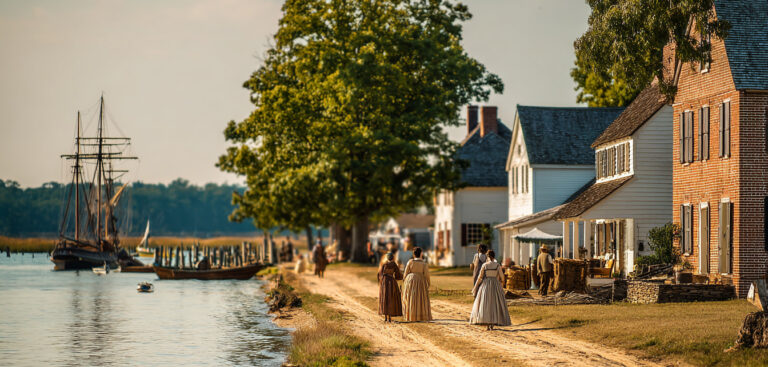
Unprecedented Biographical Dictionary of Early Virginia Immigrants
Martha McCartney uses recent historical scholarship as she sets the stage in her remarkable book, Virginia Immigrants and Adventurers, 1607-1635: A Biographical Dictionary. We’re focusing on this unprecedented trove of information, formatted as an easy to use biographical dictionary of early Virginia immigrants, and sharing an excerpt from the book.
Soon after the fateful landing of 1607, thousands of immigrants flocked to Jamestown and surrounding areas on both sides of the James and York rivers, where they struggled to maintain a foothold. This book, Virginia Immigrants and Adventurers, 1607-1635: A Biographical Dictionary, brings together a remarkable variety of primary sources concerning every significant detail known about colony’s earliest European inhabitants. Moreover, maps provided here identify the sites at which Virginia’s earliest plantations were located and enable genealogists and students of colonial history to link most of the more than 5,500 people included in this volume to the cultural landscape.
From the earliest records relating to Virginia, we learn the basics about many of these original colonists: their origins, the names of the ships they sailed on, the names of the “hundreds” and “plantations” they inhabited, the names of their spouses and children, their occupations and their position in the colony, their relationships with fellow colonists and Indian neighbors, their living conditions as far as can be ascertained from documentary sources, their ownership of land, the dates and circumstances of their death, and a host of fascinating details about their personal lives – all gathered together in the handy format of a biographical dictionary. In all, Ms. McCartney’s biographical dictionary provides annotated sketches of more than 5,500 persons linking the majority of them to a specific locality (a “hundred” or plantation) and a precise timeframe between 1607 and 1635.
In the words of Professor Kathleen Bragdon of The College of William and Mary, “Martha McCartney is the unrivaled authority on the primary sources relating to Virginia’s first European explorers and settlers.” Virginia Immigrants and Adventurers, 1607-1635: A Biographical Dictionary is the crowning achievement of her investigations into the lives and whereabouts of her subjects. No collection of Virginiana can possibly be complete without it.
Please enjoy the following excerpt from Virginia Immigrants and Adventurers, 1607-1635: A Biographical Dictionary. Note that following this section of the book, Ms. McCartney breaks new ground in the story of the first generation of English settlement in Virginia by gathering “between the covers of one book the largest congregation of Virginia founders since the colony’s ‘ancient planters’ took leave of James Fort.”
Virginia Immigrants and Adventurers, 1607-1635: A Biographical Dictionary
In early January 1608, 120 weak and famished immigrants (the 1st Supply) came ashore. Approximately nine months later, 70 more colonists landed in the 2nd Supply. Among them were two women, the first to arrive. Finally, in May 1609, a 3rd Supply of colonists set sail for Virginia. The fleet of nine ships got caught in a hurricane and in August seven of them limped into Jamestown, with 200 to 300 passengers. One small vessel went down at sea. Also missing was the flagship ‘Seaventure,’ which had run aground in Bermuda, stranding the men chosen to serve as the colony’s principal leaders. Samuel Argall arrived in Virginia in July 1609, spreading word of the Virginia Company’s plan to change the way the colony was governed. This sparked dissention, and Captain John Smith, ousted as president and injured by a gunpowder explosion, left the colony. George Percy took his place.
At Jamestown, the struggle to survive proved so arduous that the winter of 1609-1610, termed the ‘Starving Time,’ nearly led to the colony’s extinction. In May 1610, Sir Thomas Gates, Sir George Somers, and other members of the 3rd Supply reached Virginia in two vessels fashioned from Bermuda’s native cedar wood. Gates, who was ill-prepared for the dire conditions he found, resolved to evacuate the surviving colonists to Newfoundland, where they could secure passage to England. Only the timely arrival of Lord De La Warr’s three ships in June, with provisions and 250 new immigrants, averted the Virginia colony’s abandonment. De La Warr immediately put the colonists to work, cleansing and strengthening their settlement, and he dispatched Gates and Somers to Bermuda to bring back food. As it turned out, Somers died and Gates returned to England.
In May 1611 Sir Thomas Dale arrived with 300 new settlers. He was joined in August by Sir Thomas Gates, Virginia’s lieutenant governor, who brought an additional 300 people and new instructions from the Virginia Company. Together, Gates and Dale, former comrades-in-arms, fabricated a strict code of justice known as ‘The Lawes Divine and Martiall,’ which required the colonists to work toward their own support and imposed severe penalties upon the disobedient. In response to the Company’s orders to build the colony’s principal town in a healthier, more defensible location than Jamestown Island, Dale, as marshal, established several new settlements near the head of the James River in territory that became known as Charles City and Henrico. In 1614 he sent some colonists to the Eastern Shore to extract salt from seawater, so that fish could be preserved. Sir Thomas Dale, as deputy-governor, introduced several innovative policies that fostered the colony’s development. During his administration, John Rolfe developed a strain of sweet-scented tobacco that quickly became a highly marketable money crop and fueled the spread of settlement. Deputy Governor Samuel Argall, who took over in 1617-1618, pursued many of the strict policies that Dale had established.
In April 1619 incoming Governor George Yeardley suspended martial law and in accord with his instructions, subdivided the colony into four corporations: James City, Elizabeth City, Charles City, and Henrico. Each was vast in size and vaguely defined, but encompassed both sides of the James River. In July 1619 delegates from all but one of the colony’s plantations went to Jamestown, where they convened in America’s first legislative assembly. The following month another momentous event occurred. A Dutch frigate and a ship called the ‘Treasurer’ sailed into the mouth of the James River with Virginia’s first Africans aboard.
The Virginia Company’s Great Charter, which Governor Yeardley implemented, introduced a land policy known as the headright system. In synch with the fledgling tobacco economy, it was an enormous stimulus to settlement, for it provided prospective immigrants with an incentive to seek their fortunes in Virginia. It also encouraged groups of wealthy investors to underwrite the cost of outfitting and transporting prospective colonists to establish large ‘particular’ (private) plantations, sometimes known as ‘hundreds.’ Because an individual could acquire 50 acres of land by underwriting the cost of another’s transportation, successful planters could bring indentured servants to Virginia to work their land, simultaneously accumulating acreage and fulfilling their need for labor. In essence, the headright system enabled Virginia colonists to acquire real estate and work toward their own personal gain.
During Sir George Yeardley’s first term as governor (1619 to 1621), 18 or 19 new private plantations were established. Most were thinly scattered along both sides of the James River, west of the Chickahominy River’s mouth. After Sir Francis Wyatt became governor (1621 to 1626), at least a dozen new plantations were established along the James River, within largely vacant territory that was close to Jamestown Island. Unfortunately, many of the plantations seated while Governors Yeardley and Wyatt held office lay within what scientists call the oligohaline zone, an area within the James River basin where salt concentrations are especially high in summer and tidal action fails to flush away contaminants. The result was a high mortality rate. Even so, the Virginia colony grew and flourished and by March 1620 there were 928 people living within the colonized areas: 892 Europeans, 32 Africans (17 women and 15 men), and four Indians. All of the Indians and Africans were described as being ‘in ye service of severall planters.’
On March 22, 1622, the Native population, threatened by the inroads of expanding settlement, launched a carefully orchestrated attack upon the sparsely inhabited plantations along the James River. It was a vigorous attempt to drive the colonists from their soil. At the end of the day, an estimated 347 men, women, and children reportedly were dead, just over a third of the colony’s population. Although the survivors withdrew to eight settlements that were strengthened and held, by autumn 1623 many colonists had begun reoccupying the outlying plantations they had abandoned. Again, settlement began to spread and by the mid-1620s the Virginia colony had become well established. In February 1624, when a community-by-community census was made of the colony’s inhabitants, at least 906 people were living within the settled area and another 371 colonists had died since April 1623. By January and February 1625 the number of living colonists had soared to 1,232.
In May 1624 the Virginia Company’s charter was revoked and Virginia became a Crown colony. Although the settlers weathered a period of uncertainty, their concern about their land titles’ validity was quickly put to rest. However, the legal dilemma posed by the defunct Virginia Company’s ownership of land proved to be more troublesome. Surviving land patents reveal that for the first decade after the Company’s dissolution, the tracts of land its leaders had set aside to generate income for investors were let to leaseholders. Despite some half-hearted attempts to revive the Virginia Company, by the early-to-mid 1630s patents were issued for those parcels.
In 1634 the colony was subdivided into eight shires or counties, each of which was to have a local court with justices, a sheriff, a clerk, and other functionaries. It was then that James City, Charles City, Elizabeth City (Kecoughtan), Henrico, Warwick, York (Charles River), Isle of Wight (Warresqueak), and Accomack counties were formed, replacing the four corporations that previously existed. The establishment of county courts, whose authority increased over time, relieved the Quarter Court of many routine matters, freeing it to handle important cases and function as an appellate body. In 1634 the colony had a population of 4,914, and new immigrants were arriving constantly.
Image credit: The Thomas Jefferson Papers Series 8. Virginia Records Manuscripts. 1606-1737.
Virginia, 1606-92, Charters of the Virginia Company of London, via the Library of Congress American Memory Collection.



